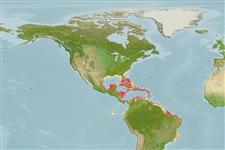>
Atheriniformes (Silversides) >
Atherinidae (Silversides) > Atherinomorinae
Etymology: Atherinomorus: Greek, atherina, the Greek name for the eperlane + Greek, moros = silly, stupid (Ref. 45335).
More on authors: Müller & Troschel.
Environment: milieu / climate zone / depth range / distribution range
Écologie
marin; eau douce; saumâtre récifal. Subtropical
Western Atlantic: southern Florida (USA), Bahamas, and Yucatan, Mexico to Brazil. Southeast Pacific: known only from Tumaco, Colombia (Ref. 9273).
Length at first maturity / Taille / Poids / Âge
Maturity: Lm 6.0 range ? - ? cm
Max length : 10.0 cm TL mâle / non sexé; (Ref. 7251); common length : 7.5 cm TL mâle / non sexé; (Ref. 5217)
Épines dorsales (Total): 10 - 11; Rayons mous dorsaux (Total): 8-10; Rayons mous anaux: 9 - 13. Head wider than body (Ref. 26938).
Found over soft bottoms as well as in coral reefs (Ref. 5217). Often in large schools (Ref. 5521). Feeds on zooplankton (Ref. 5217).
Life cycle and mating behavior
Maturité | Reproduction | Frai | Œufs | Fécondité | Larves
Lavenberg, R.J. and M. Chernoff, 1995. Atherinidae. Pejerreyes. p. 889-901. In W. Fischer, F. Krupp, W. Schneider, C. Sommer, K.E. Carpenter and V. Niem (eds.) Guia FAO para Identification de Especies para lo Fines de la Pesca. Pacifico Centro-Oriental. 3 Vols. FAO, Rome. (Ref. 9273)
Statut dans la liste rouge de l'IUCN (Ref. 130435)
Menace pour l'homme
Harmless
Utilisations par l'homme
Pêcheries: intérêt commercial mineur; appât: usually
Plus d'informations
RéférencesAquacultureProfil d'aquacultureSouchesGénétiqueElectrophoresesHéritabilitéPathologiesTraitementNutrientsMass conversion
CollaborateursImagesStamps, Coins Misc.SonsCiguateraVitesseType de nageSurface branchialeOtolithesCerveauxVision
Outils
Articles particuliers
Télécharger en XML
Sources Internet
Estimates based on models
Preferred temperature (Ref.
123201): 26.3 - 28.2, mean 27.5 °C (based on 695 cells).
Phylogenetic diversity index (Ref.
82804): PD
50 = 0.5005 [Uniqueness, from 0.5 = low to 2.0 = high].
Bayesian length-weight: a=0.00708 (0.00405 - 0.01239), b=3.12 (2.96 - 3.28), in cm total length, based on LWR estimates for this species & (Sub)family-body (Ref.
93245).
Niveau trophique (Ref.
69278): 3.3 ±0.3 se; based on diet studies.
Résilience (Ref.
120179): Haut, temps minimum de doublement de population inférieur à 15 mois (Preliminary K or Fecundity.).
Fishing Vulnerability (Ref.
59153): Low vulnerability (10 of 100).
Nutrients (Ref.
124155): Calcium = 74.6 [30.4, 207.3] mg/100g; Iron = 0.72 [0.36, 1.36] mg/100g; Protein = 20.3 [18.0, 22.6] %; Omega3 = 0.229 [0.097, 0.578] g/100g; Selenium = 9.05 [3.59, 22.93] μg/100g; VitaminA = 106 [31, 377] μg/100g; Zinc = 1.51 [0.88, 2.41] mg/100g (wet weight);
